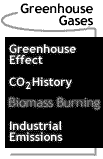

 |
Greenhouse Gases:
Biomass Burning Biomass burning is a significant source of carbon release to the atmosphere each year. Biomass burning sources include deforestation, grass fires in savannas to prepare range land for cattle, disposing of agricultural wastes, fuel wood for heating and cooking, production and use of charcoal, and natural wildfires. Wildfires constitute an almost insignificant fraction of emissions (see Yellowstone Biomass Burning activity). Biomass burning is geographically isolated, with 87% of emissions coming from the tropics. The table below lists the amount of biomass burned and carbon released to the atmosphere each year. The values listed have an uncertainty of at least 25%. The units are Tg/yr. A Tg (teragram) = 1012 gm.
Data: Andreae, M. O. (1991). Biomass burning: Its history, use and distribution, and its impact on environmental quality in global climate. In J. S. Levine (Ed.), Global biomass burning: Atmosphere, climatic, and biospheric implications (p. 8). Cambridge, MA: MIT Press. Carbon released was calculated by assuming a 45% carbon content in the biomass, except for charcoal, where 1.4 was used to account for emissions during production. Between biomass burning and industrial emissions, roughly 10,000 Tg of carbon are released to the atmosphere each year. This means that biomass burning constitutes 40% of all emissions. Why is there such a high uncertainty (25%) in the amount of biomass burned and carbon released? First, we must know the extent of the area burned. This we can get from remote sensing images. Second, we must know how much of the biomass actually burned. Rarely does all of the material burn. Values for fraction of biomass burned range from 0.30 for forests to 1.00 for grasslands. These values will be affected by how quickly the fire burns and the moisture content of the biomass. Third, we need to know how much carbon is in the vegetation. The best value is 45.5%, with a standard deviation of 3.3% (Lobert, 1991). Trees tend to have more carbon than grasses and shrubs. This is only part of the picture, however, since the density of material is very important, for example, how many trees per acre, so values of g C/m2 are usually used. (For all the fun of actually doing such a calculation, see Yellowstone Biomass Burning activity. The problem of biomass burning and carbon release gets even more difficult if we want to know how much CO2, CO, CH4, or other hydrocarbons were released. This depends on the conditions of the burn. During flaming-hot fires, the dominant gas released is CO2. But once the fire begins to smolder, combustion is no longer complete, and CO and other hydrocarbons become a significant fraction of the emissions. After the fire, the remaining material is slowly decomposed by bacteria and fungi, with significant amounts of carbon being released, possibly as CH4. Why should we care how much carbon is released as CO2 or CH4? In the opening page of this section, we learned that different gases have different global warming potentials. So the climatic impact of a given fire will depend on the amount of each gas released. In any discussion of biomass burning, we must remember that the amount of carbon released as shown in the table above is only part of the story. The savannas and areas burned for agricultural purposes regrow within a year, absorbing carbon. So these sources do not represent a net release of carbon to the atmosphere. Note from the table that these two sources constitute nearly two-thirds of biomass emissions. The significant loss is in forests, whose wood sequesters carbon for long periods of time. Quick Fact: 1 million metric tons of carbon is equal to the added annual carbon storage of 1 million acres of a well-established, rapidly growing stand of mixed-species trees Source: USEPA.
[ Greenhouse Gases: Greenhouse Effects / [ Home ] [ Teacher Pages ] [ Modules & Activities ] |
HTML code by Chris Kreger
Maintained by ETE Team
Last updated November 10, 2004
Some images © 2004 www.clipart.com
Privacy Statement and Copyright © 1997-2004 by Wheeling Jesuit University/NASA-supported Classroom of the Future. All rights reserved.
Center for Educational Technologies, Circuit Board/Apple graphic logo, and COTF Classroom of the Future logo are registered trademarks of Wheeling Jesuit University.